“Well, here I am in a foreign land again. I saw a Dutch windmill the other day, and it’s just like in the books I used to read, but you don’t see any flowers or rosy-cheeked girls in sun bonnets. Instead, you see shell craters, ruined houses. Some of the girls are pretty, but I wouldn’t trade two dozen of them for any of the girls in Mariposa.”
Julian Sargentini, in a letter written to his sister on February 21, 1945, sent from “somewhere in Holland.”
The first time we spotted Julian “Sarg” Sargentini, he was aloft. Though he’s 90 years old now, he was actively trimming a tree on his property. We were there to meet his grandchildren for a story about their dogs, and it was immediately apparent that Mr. Sargentini was also a man with many stories to tell.
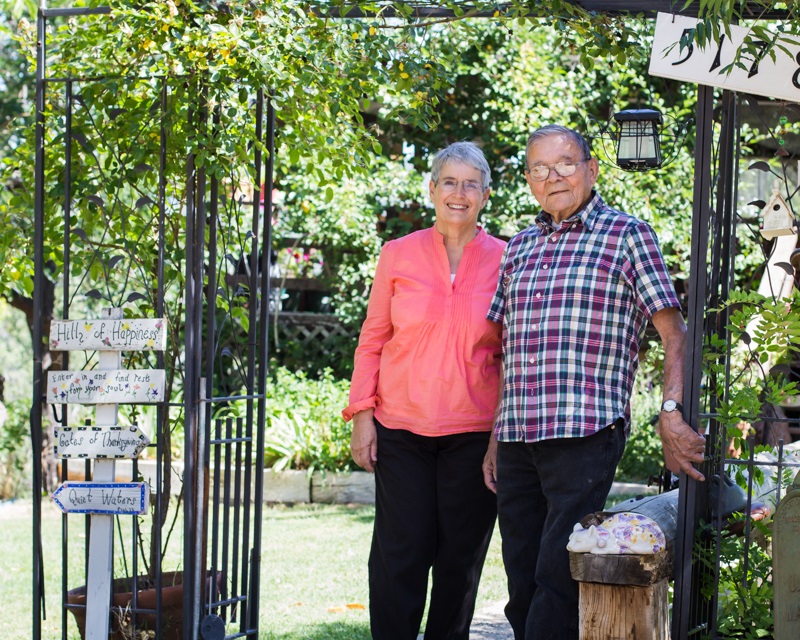 His tree-trimming skills alone would qualify him as interview material. Once we learned his age, and that he was a veteran of World War II, and in particular the Battle of the Bulge, we knew we had to return for a visit with the charming man who said to call him, simply, “Sarg.”
His tree-trimming skills alone would qualify him as interview material. Once we learned his age, and that he was a veteran of World War II, and in particular the Battle of the Bulge, we knew we had to return for a visit with the charming man who said to call him, simply, “Sarg.”
One could write a story about any decade in the life of Sarg. He was born in Arizona in 1924, and it wasn’t long before his family migrated to Placerville and then, to Mariposa. His dad was a miner and his mom was a cook at the Diltz Mine, just five miles northwest of Mariposa, where she ran a boarding house. Sarg says she probably made more money than the miners in those days.
As a youngster, he’d pan for gold and take his finds to town. He soon realized that there were “no jobs for a young guy,” and somehow, he was talked into dropping out of high school in his sophomore year and joining up with the “three Cs,” that is, the Civilian Conservation Corps (CCC).
 There he continued his schooling and worked as an unskilled laborer. The CCC was a major part of President Franklin D. Roosevelt’s New Deal, where young men could find jobs after the Great Depression, working at conserving and developing rural lands owned by federal, state and local governments.
There he continued his schooling and worked as an unskilled laborer. The CCC was a major part of President Franklin D. Roosevelt’s New Deal, where young men could find jobs after the Great Depression, working at conserving and developing rural lands owned by federal, state and local governments.
During its nine years of operation, from 1933 to 1942, about three million men participated in the CCC. That’s how Sarg found himself in Alaska on December 7, 1941, the day the Japanese bombed Pearl Harbor. The next day, the U.S. declared war on Japan.
“We were building an airbase at the time on Annette Island,” Sarg explained, sitting on the sun-dappled porch of his Oakhurst home, more than seven decades later. “I was there a year, and then when I turned 18, I was drafted.”
World War II began in 1939 and ended in 1945, and is remembered as the deadliest and most destructive war in history. Following the Great Depression, the economy was devastated, unemployment was high, and massive inflation had devalued currency around the world. More than fifty nations were fighting, and over 100 million soldiers were deployed.
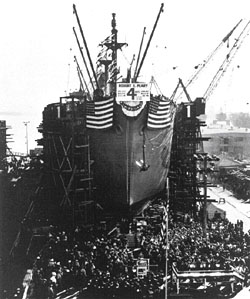 After his work in Alaska, Sarg returned to the states and spent some time back at home in Mariposa before he went into the army, working in the Kaiser shipyards in Richmond, California, as an apprentice welder. Sarg worked on one of the Liberty Ships that came to be a symbol of U.S. wartime industrial output. Working ’round-the-clock with thousands of others, a massive ship could be built in a matter of days.
After his work in Alaska, Sarg returned to the states and spent some time back at home in Mariposa before he went into the army, working in the Kaiser shipyards in Richmond, California, as an apprentice welder. Sarg worked on one of the Liberty Ships that came to be a symbol of U.S. wartime industrial output. Working ’round-the-clock with thousands of others, a massive ship could be built in a matter of days.
“From there I went to Monterey, to the Presidio, where I was inducted and spent about a week getting indoctrinated and being told what the army was all about. I wound up in the 75th Infantry Division in Fort Leonard Wood, Missouri.” Following the 75th’s activation, Sarg went through basic training and on to maneuvers in Louisiana and Kentucky. 1943 turned into 1944 as World War II marked its pages in history.
“All we ever read was war stories. We didn’t have television, all we had was radio, and radio didn’t keep up with the war over there. We heard about it, but I wasn’t afraid because I didn’t know the horrors of war, so the war was a world away from us. We never heard about casualties or anything like that, so we just kind of drifted along.“
 Sarg went into Special Troops, and when the army was divided into regiments and shipped overseas, Sarg was part of the contingent that managed communications.
Sarg went into Special Troops, and when the army was divided into regiments and shipped overseas, Sarg was part of the contingent that managed communications.
“They had several thousand men in each regiment. I was what they call a lineman, a communications man. You can’t have an army without communications. When we crossed the channel and landed in Europe, it was after D-Day. They never explained it, but we knew we were fighting the Germans because they had started the war and gone into Europe and Poland and Czechoslovakia and they were headed for Russia. That’s all we knew.”
Sarg and the other fresh troops landed in the fall, thinking they would be occupation troops. They were immediately sent to the lines, just in time for the Battle of the Bulge.
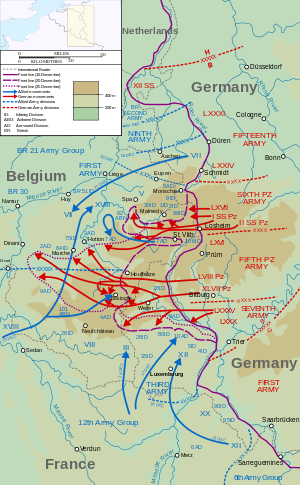 The Battle of the Bulge was a major German offensive campaign, launched through the dense, snow-blanketed forests of Belgium, France and Luxembourg on the Western Front toward the end of the war. Hitler planned to recapture the harbor of Antwerp, and the surprise attack caught the Allied forces off-guard. U.S. forces incurred the highest casualties for any operation during the war. The phrase “Battle of the Bulge” was used to describe how the Allied front line bulged inward on wartime news maps. (Wikipedia)
The Battle of the Bulge was a major German offensive campaign, launched through the dense, snow-blanketed forests of Belgium, France and Luxembourg on the Western Front toward the end of the war. Hitler planned to recapture the harbor of Antwerp, and the surprise attack caught the Allied forces off-guard. U.S. forces incurred the highest casualties for any operation during the war. The phrase “Battle of the Bulge” was used to describe how the Allied front line bulged inward on wartime news maps. (Wikipedia)
“Our division was broken up into three different outfits, and we gained experience by following the experienced troops. We went with the 3rd Armored, went up on the lines and saw action for the first time. General George Patton, he was quite a go-getter,” Sarg recalls. “The other troops knew what they were doing, but a lot of our guys did not. We lost quite a few men.”
Sarg recounts the first time he saw a tank get hit by a shell.
“The gun was facing toward the enemy and when they fired at us, the shell ran right alongside the barrel, hit the commander of the tank right in the face and blew up everything.”
Sarg has visceral memories of what he experienced, but the thing he recalls most about those desperate times is “snow. Nothing but snow.” To this day, hearing Bing Crosby singing White Christmas causes him to be overcome with emotion.
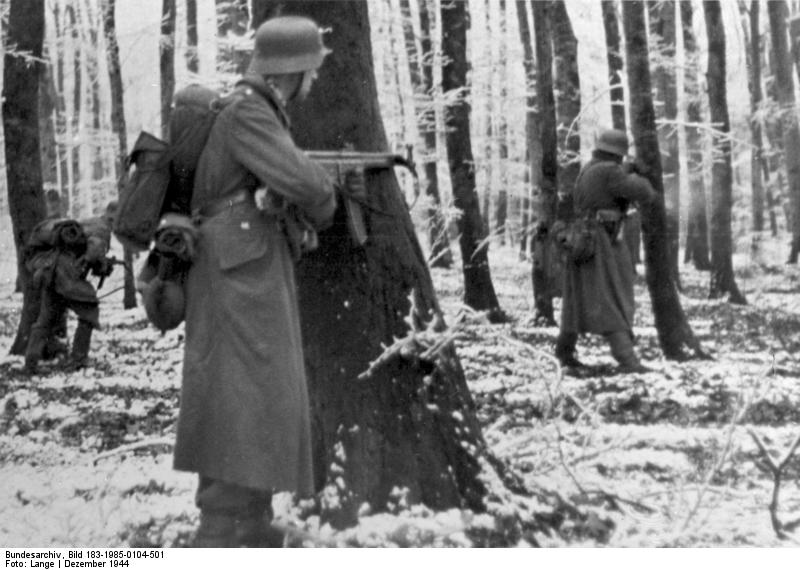 On one of those cold, white days in the dead of winter, the young soldier was challenged emotionally in a way that remains with him to this day.
On one of those cold, white days in the dead of winter, the young soldier was challenged emotionally in a way that remains with him to this day.
“We were accompanying a group of engineers. They were digging up mines and one of them stepped on a mine and I think there were eight men, just blown up.” Sarg was hit by flying shrapnel.
“A piece of metal went through my helmet and I remember the Lieutenant coming by, and he said, ‘Soldier. Are you hurt?'”
Sarg wasn’t sure if he was hurt or not.
“I couldn’t feel too much, but I could move, so I said, ‘No, I don’t think so.’ So he said, ‘help me out over here.’ About that time the medics had set up an aid station, so we dragged some of the wounded guys over to the aid station, I don’t know how many. I dragged one sergeant over, but he died on the way. They told me just to lay him alongside the little road.”
That’s when he noticed the watch.
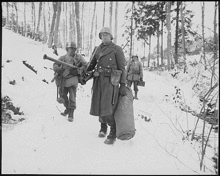 “I had wanted one of those GI watches that the army used to issue, because they glowed in the dark. They were something. Every soldier wanted one, but only the Sergeants and some others got one.
“I had wanted one of those GI watches that the army used to issue, because they glowed in the dark. They were something. Every soldier wanted one, but only the Sergeants and some others got one.
“As I dragged the Sergeant out there and folded his arms over his chest, that glow in the dark watch was staring me right in the face,” Sarg says, choking back tears. “I thought about taking it, but I thought, ‘No I couldn’t take it off of a dead man.'” Sarg is visibly shaken by the memory. “Then his arm rolled down and I picked it up and saw it again, but I still didn’t take it. I just left him.”
In the midst of such traumatic times, it’s strange, the notions that stay with us, and the vivid recollections of long ago. Sarg, just twenty years old, was growing up faster than any timepiece could keep track of anyway. And he didn’t have time to dwell on it; there was a war going on all around him.
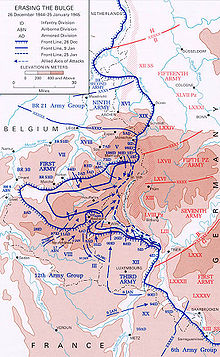 “About that time our division started shelling and everyone along the lines started shelling and we gave the Germans a midnight greeting, more or less.” He remembers the guns going off from the front lines to the rear in a barrage that seemed to last forever but in reality, was only a matter of minutes. There were mortars from the front lines, and artillery half-a-mile back.
“About that time our division started shelling and everyone along the lines started shelling and we gave the Germans a midnight greeting, more or less.” He remembers the guns going off from the front lines to the rear in a barrage that seemed to last forever but in reality, was only a matter of minutes. There were mortars from the front lines, and artillery half-a-mile back.
“At the time, you’re scared, but you don’t have time to worry about being scared. You have a job to do, so you’re doing it. Afterwards, you start thinking, ‘I could have been killed!’ You start shaking, or thinking about it, or worrying about it.” But there was little time for reflection, and Sarg, like the others in the midst of this organized chaos, learned to cope.
“After a while, you get used to things around you, and you kind of form a hard shell. You can go about your duties; you’re scared, yes, but not like you were at the beginning. You’re afraid, but you know the shortcuts and how to fend for yourself, more or less.”
As the year wore on, Sarg plodded through the carnage of war, walking all the way from France into Germany as the troops engaged the enemy.
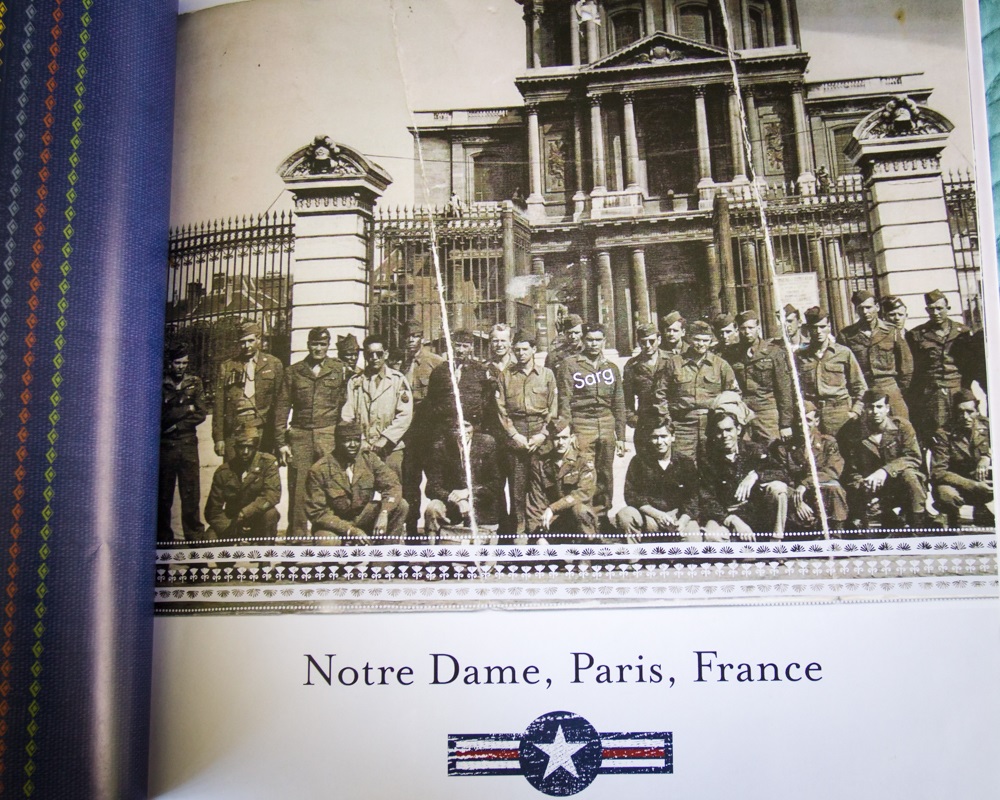 “We were involved in three major battles. I survived a lot of bad and a lot of good. Good would be the occupation part of the war after the fighting was over. We were in the little town of Lindtfort, a little mountain town bigger than Fish Camp, but it looked like Yosemite. It was beautiful. The war hadn’t touched it because it was so remote.
“We were involved in three major battles. I survived a lot of bad and a lot of good. Good would be the occupation part of the war after the fighting was over. We were in the little town of Lindtfort, a little mountain town bigger than Fish Camp, but it looked like Yosemite. It was beautiful. The war hadn’t touched it because it was so remote.
“At that time, all we had to do was ride around the country picking up Germans who had gotten away and didn’t know that the war was over. Or maybe they knew the war was over, but they didn’t know what to do. We would gather these German soldiers and send them to the rear.”
With hostilities ended and their mission accomplished, Sarg and his fellow soldiers at last headed for home.
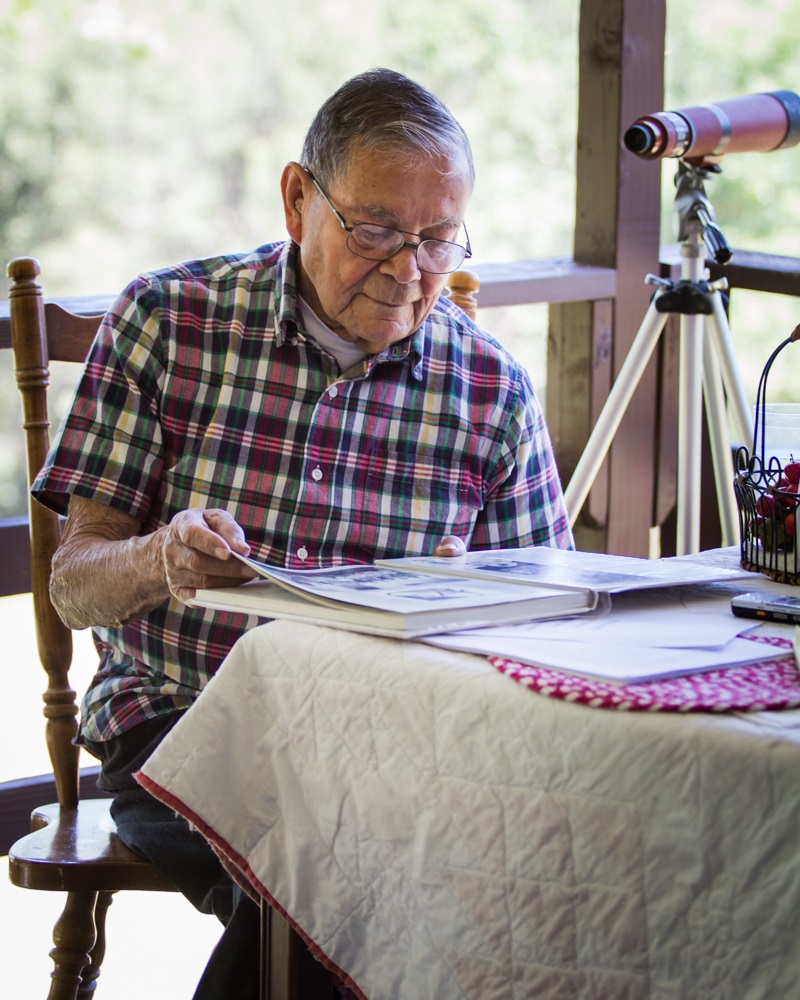 Back in Mariposa after his service overseas, Sarg thought he would just hang around and collect a paycheck. That worked for a month or so, and then he got bored, ready to start the rest of his life. Like so many who served and survived World War II, Julian Sargentini went about his business, working for a living, raising a family, and eventually finding a career in the mountains with PG&E.
Back in Mariposa after his service overseas, Sarg thought he would just hang around and collect a paycheck. That worked for a month or so, and then he got bored, ready to start the rest of his life. Like so many who served and survived World War II, Julian Sargentini went about his business, working for a living, raising a family, and eventually finding a career in the mountains with PG&E.
As he reminisces, it’s not hard to understand why men and women of his ilk have been dubbed “The Greatest Generation.”
Living now surrounded by his grandchildren, on a heavenly spread overlooking the forest not unlike those overseas, Sarg seems utterly at peace. While he credits his wife Susan for much of his success, Sarg agrees that his year fighting the war was a formative period in his life.
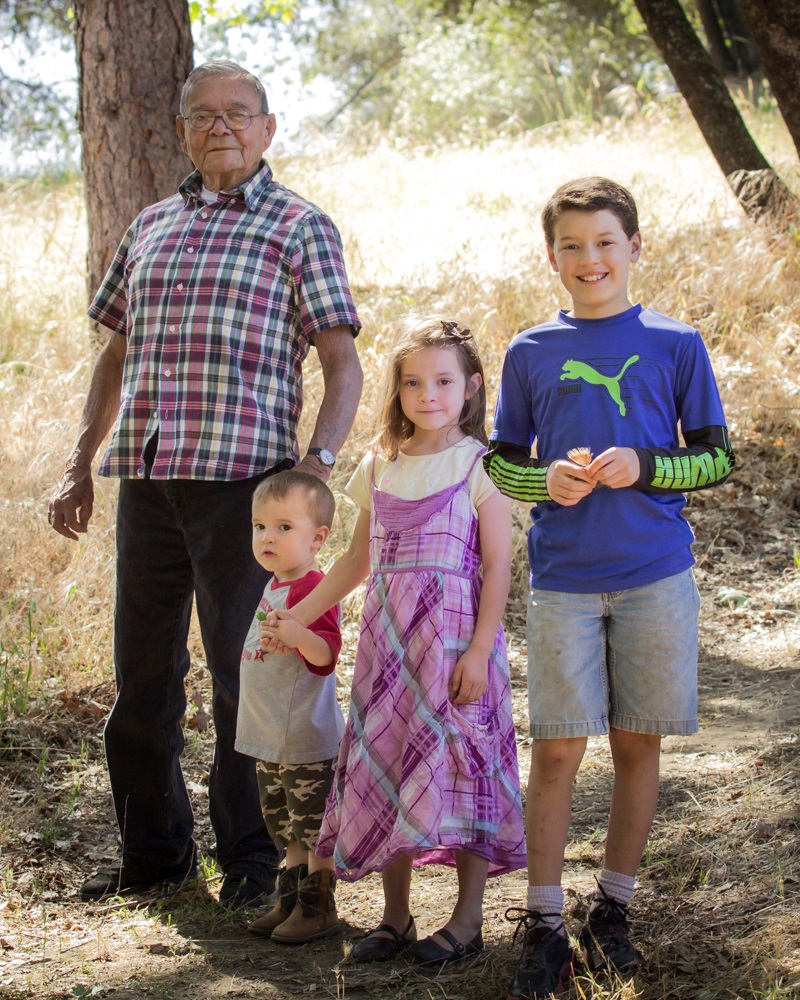 “It was an experience, put it that way. It gave me a lot of responsibility, caused me to wake up and become more of a man. It was an experience you never forget, you wouldn’t want to be in it again and you’re glad you lived through it.”
“It was an experience, put it that way. It gave me a lot of responsibility, caused me to wake up and become more of a man. It was an experience you never forget, you wouldn’t want to be in it again and you’re glad you lived through it.”
Thank you, Mr. Sargentini, for your service.
(Historical photographs from a family collection compiled in a book given to Mr. Sargentini by his daughter Alicia Becker for his 90th birthday. Present-day photographs by Virginia Lazar. Click on images to enlarge.)

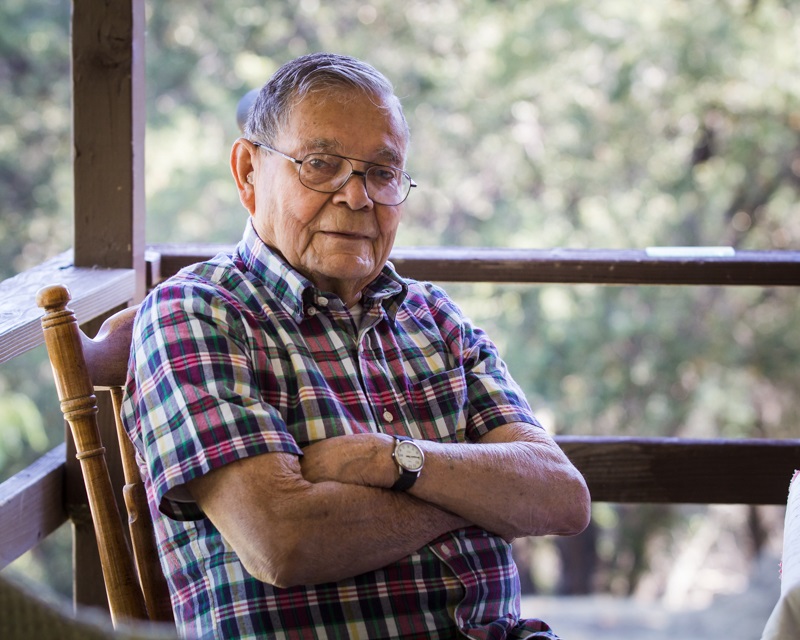

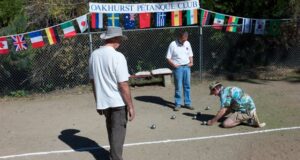

Kelli… Thank you so much for your time and effort in this excellent article on Sarge. He has always been my hero but you have shown him to the entire community. Thanks again. Susan and Sarg Sargentini
My treasured friend. We met in a Oakhurst High School gym, a first night rehearsal of the Golden Chain Theatre summer melodrama production, “M’Lis”. I was cast for the lead, and tom-girl’s miner father was Sarg. He never “done” theatre before. What a thespian and team player. Our friendship began, and cherish the memories. Thanks to Kelli for such a well written article. Bev (Fort Collins, CO)
Sarg, my treasured friend. We met in a Oakhurst High School gym, a first night rehearsal of the Golden Chain Theatre summer melodrama production, “M’Lis”.
I was cast for the lead, and the tom-girl’s miner father was Sarg. He had never “done” theatre before. What a thespian and team player!!! Our friendship began, and cherish the memories. Thanks to Kelli for such
a well written article. Bev (Fort Collins, CO)
Kellie,
I remember that day day you were doing the story on our Diabetes Alert Dogs, and I told you the “real” story was the 90 year old man trimming trees with his pole saw, while elevated in a 40-foot boom next door! Every day I thank the Lord for giving me and my family another day with this priceless man. Thank you for your well-written tribute to him and his service to our country.
He is truly an amazing guy. I am one of the fortunate people to say I know him. I know the enrichment and impact He and his family have had on me. It’s nice that more people know about this very warm and humorous guy. Happy to say he is my friend.
What a wonderful story!! I teared up reading it because I was 7 years old when my Grandpa passed away suddenly and didn’t get to hear his WWII Battle of the Bulge stories first hand. He was also in the CCC before joining the Army and was a Heavy Machine Gunner in the 28th Infantry, 109th Division – through Normandy, Ardennes & Battle of the Bulge…he earned a Purple Heart & a bronze star. These men are the true definition of hero.
What an amazing article and Man. Fortunate to have known this family since I was a boy and I’m a bit ashamed I did not know more about his service. Thanks for writing the article.